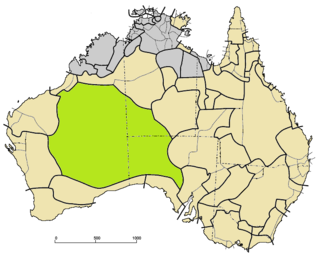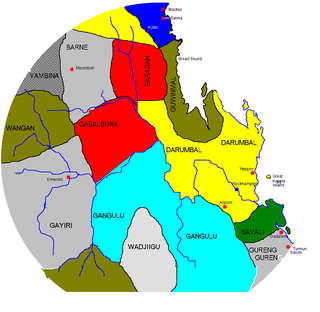Classification

Worimi is most closely related to Awabakal, in the Yuin–Kuric group of Pama–Nyungan.
Bowern (2011) considers Gadjang, Worimi, and Birrpayi to be separate languages.[ citation needed ]
| Worimi | |
|---|---|
| Gadhang | |
| Lower North Coast language | |
| Region | New South Wales |
| Ethnicity | Worimi, Birpai, Gringai |
| Extinct | (date missing) |
| Dialects |
|
| Language codes | |
| ISO 639-3 | kda – inclusive codeIndividual code: xbj – Birrpayi |
| Glottolog | wori1245 Worimi |
| AIATSIS [2] | E67 |
| ELP | Birrpayi |
Worimi (also spelt Warrimay), or Gadjang (also spelt Kattang, Kutthung, Gadhang, Gadang, Gathang) is an Australian Aboriginal language. It is the traditional language of the Worimi people, whose descendants now speak English. Work has started on revitalising the language with a dictionary and TAFE course in Gathang. [3]

Worimi is most closely related to Awabakal, in the Yuin–Kuric group of Pama–Nyungan.
Bowern (2011) considers Gadjang, Worimi, and Birrpayi to be separate languages.[ citation needed ]
| Front | Back | |
|---|---|---|
| High | ɪ iːi ii | ʊ uːu uu |
| Low | ə aːa aa | |
There is also the diphthong "ay", pronounced [aj].
| Bilabial | Velar | Dental | Palatal | Alveolar | |
|---|---|---|---|---|---|
| Voiceless Stop | pp | k k | t̪ th | c tj | t t |
| Voiced Stop | b b | g g | d̪ dh | ɟ dj | d d |
| Nasal | mm | ŋng | n̪nh | ɲny/yn | nn |
| Lateral | ll | ||||
| Approximant | ww | jy | ɹ~ɾ r | ||
| Flap/Trill | ɾ~r rr | ||||
Within the orthography, both voiceless and voiced stops are written, words begin with voiced stops only and only voiced stops may occur in consonant clusters or suffixes. There is some inconsistency in the orthography to choice of stop intervocalically, the dictionary/grammar written by Amanda Lissarrague prescribes voiceless stops intervocalically, but this is violated many times such as in magu - axe. The phonemes /p/ and /b/ may contrast, such as gaparr - baby, boy, and gabarr - head. This is unclear.
There is some evidence of a merger of the dental and palatal stops/nasals, with free variation existing in many words, such as djinggarr~dhinggarr - silver, grey.
At the end of a word, a nasal may also be pronounced as its corresponding stop. (E.g. bakan~bakat - rock).
Intervocalically, "b" may be pronounced as [v].

Dyirbal is an Australian Aboriginal language spoken in northeast Queensland by about 29 speakers of the Dyirbal people. It is a member of the small Dyirbalic branch of the Pama–Nyungan family. It possesses many outstanding features that have made it well known among linguists.
Jiwarli is an Australian Aboriginal language formerly spoken in Western Australia. It is a variety of the Mantharta language of the large Pama–Nyungan family.

The Wonnarua people, otherwise written Wanarruwa, are a group of Aboriginal Australian people united by strong ties of kinship, and who survived in family groups or clans scattered along the inland area of what is now known as the Upper Hunter Valley, New South Wales, Australia. Their creation spirit is Baiami, also known as Koin, the creator of all things and the Keeper of the Valley.
Martuthunira is an extinct Australian Aboriginal language, that was the traditional language of the Martuthunira people of Western Australia.
Awabakallanguage is an Australian Aboriginal language that was spoken around Lake Macquarie and Newcastle in New South Wales. The name is derived from Awaba, which was the native name of the lake. It was spoken by Awabakal and Wonnarua peoples.

The Western Desert language, or Wati, is a dialect cluster of Australian Aboriginal languages in the Pama–Nyungan family.
Darkinjung is an Australian Aboriginal language, the traditional language of the Darkinjung people. While no audio recordings of the language survive, several researchers have compiled wordlists and grammatical descriptions. It has been classified as a language no longer fully spoken and it can be classified as needing a language renewal program. It was spoken adjacent to Dharuk, Wiradhuri, Guringai, Gamilaraay, and Awabakal. The Darkinjung tribe occupied a small part of southeastern Australia inside what is now the New South Wales area. They likely inhabited a considerable tract of land within Hunter, Northumberland, and Cook counties.

Prior to the arrival of Europeans, Australian Aboriginal languages had been purely spoken languages, and had no writing system. On their arrival, Latin script became a standard for transcription of Australian Aboriginal languages, but the details of how the sounds were represented has varied over time and from writer to writer, sometimes resulting in a great many variant spellings of the same word or name.

The Adnyamathanha language, also known as yura ngarwala and other names, and Kuyani, also known as Guyani and other variants, are two closely related Australian Aboriginal languages. They are traditional languages of the Adnyamathanha of and the Kuyani peoples, of the Flinders Ranges and to the west of the Flinders respectively, in South Australia.
Diyari or Dieri is an Australian Aboriginal language spoken by the Diyari people in the far north of South Australia, to the east of Lake Eyre. It was studied by German Lutheran missionaries who translated Christian works into the language in the late 19th and early 20th centuries, so that it developed an extensive written form. Only a few fluent speakers of Diyari remained by the early 21st century, but a dictionary and grammar of the language was produced by linguist Peter K. Austin, and there is a project under way to teach it in schools.

Gumbaynggir language is an Australian Aboriginal language spoken by the Gumbaynggirr, who are native to the Mid North Coast of New South Wales. Gumbaynggir is the only surviving language in the Gumbaynggiric family of Pama–Nyungan stock.
Nukunu is a moribund Australian Aboriginal language spoken by Nukunu people on Yorke Peninsula, South Australia. As of 2017, there is a revival and maintenance programme under way for the language.
Bidjara, also spelt Bidyara or Pitjara, is an Australian Aboriginal language. In 1980, it was spoken by twenty elders in Queensland between the towns of Tambo and Augathella, or the Warrego and Langlo Rivers. The language is being revitalised and is being taught in local schools in the region.

The Paakantyi language, also spelt Paakantji, Barkindji, Barkandji, and Baagandji, and also known as the Darling language, is a nearly extinct Australian Aboriginal language spoken along the Darling River in New South Wales from present-day Bourke to Wentworth and including much of the back country around the Paroo River and Broken Hill. The people's and language name refers to the Paaka with the suffix -ntyi meaning "belonging to". The speakers of the language are known as the Paakantyi.
The Ndjébbana language, also spelt Djeebbana and Ndjebanna and also known as Kunibidji, is a Burarran language spoken by the Gunavidji (Ndjebbana) people of North-central Arnhem Land in the Northern Territory of Australia.
Dhauwurd Wurrung is a term used for a group of languages spoken by various groups of the Gunditjmara people of the Western District of Victoria, Australia. Keerray Woorroong is regarded by some as a separate language, by others as a dialect. The dialect continuum consisted of various lects such as Kuurn Kopan Noot, Big Wurrung, Gai Wurrung, and others. There was no traditional name for the entire dialect continuum and it has been classified and labelled differently by different linguists and researchers. The group of languages is also referred to as Gunditjmara language and the Warrnambool language.
Yaygir is an extinct Australian Aboriginal language. It was spoken by the Yaygir people in the Northern Rivers region of New South Wales.
Worimi is a small family of two to five mostly extinct Australian Aboriginal languages of New South Wales.
Guugu Yalandji (Kuku-Yalanji) is an Australian Aboriginal language of Queensland. It is the traditional language of the Kuku Yalanji people. Despite conflicts between the Kuku Yalanji people and British settlers in Queensland, the Kuku Yalanji language has a healthy number of speakers, and that number is increasing. Though the language is threatened, the language use is vigorous and children are learning it in schools. All generations of speakers have positive language attitudes. The Kuku Yalanji still practice their traditional religion, and they have rich oral traditions. Many people in the Kuku Yalanji community also use English. 100 Kuku Yalanji speakers can both read and write in Kuku Yalanji.

Darumbal, also spelt Dharambal, is an Aboriginal Australian language of Queensland in Australia declared extinct. It was spoken in the Rockhampton area of Queensland. Dialects were Guwinmal, Karunbara, Rakiwara, and Wapabura. It is classified with Bayali as a Kingkel language, but the two are not close, with a low 21% shared vocabulary. Indeed, Angela Terrill states that "there is no evidence on which to base a claim of a low-level genetic group including Dharumbal with any other language".